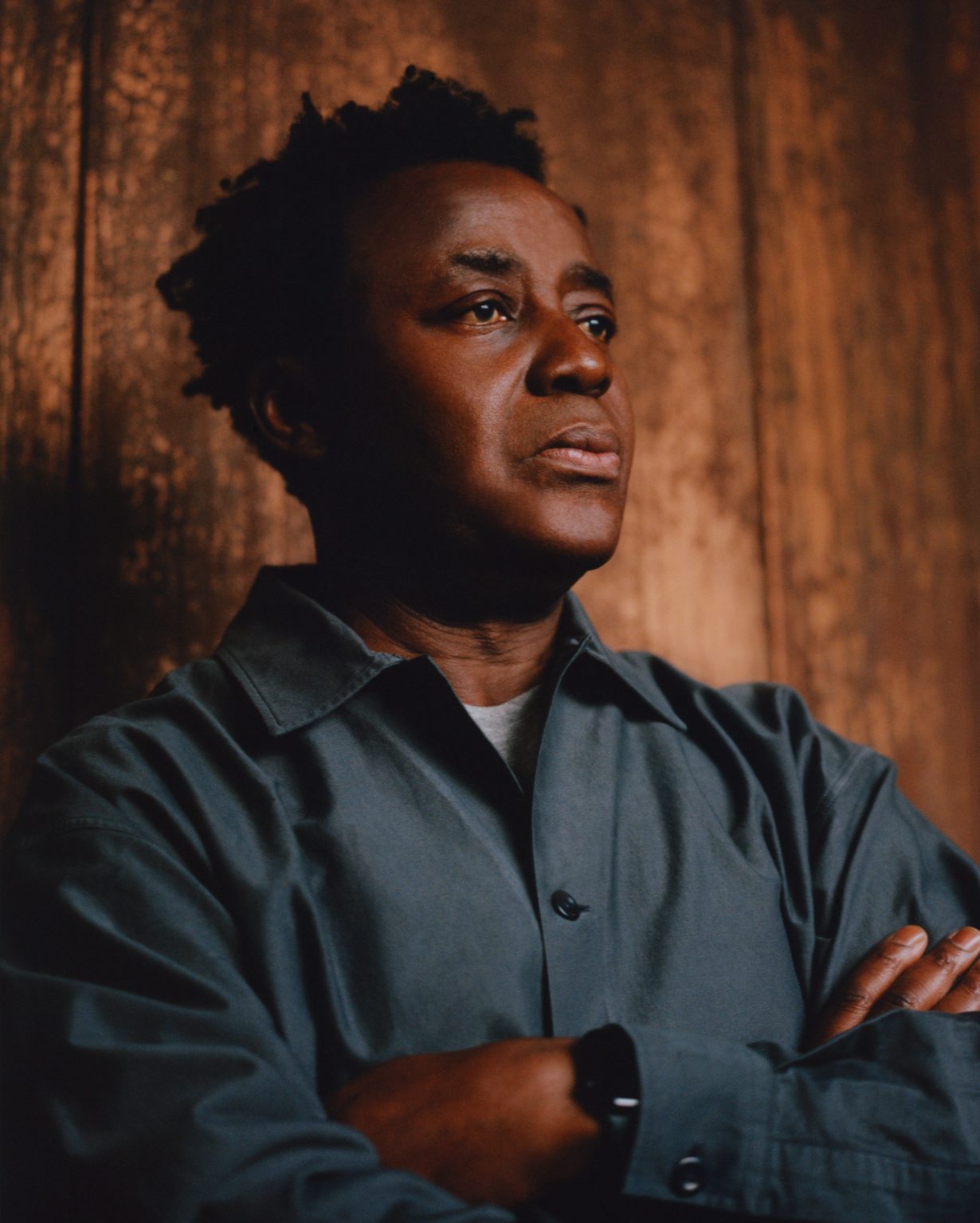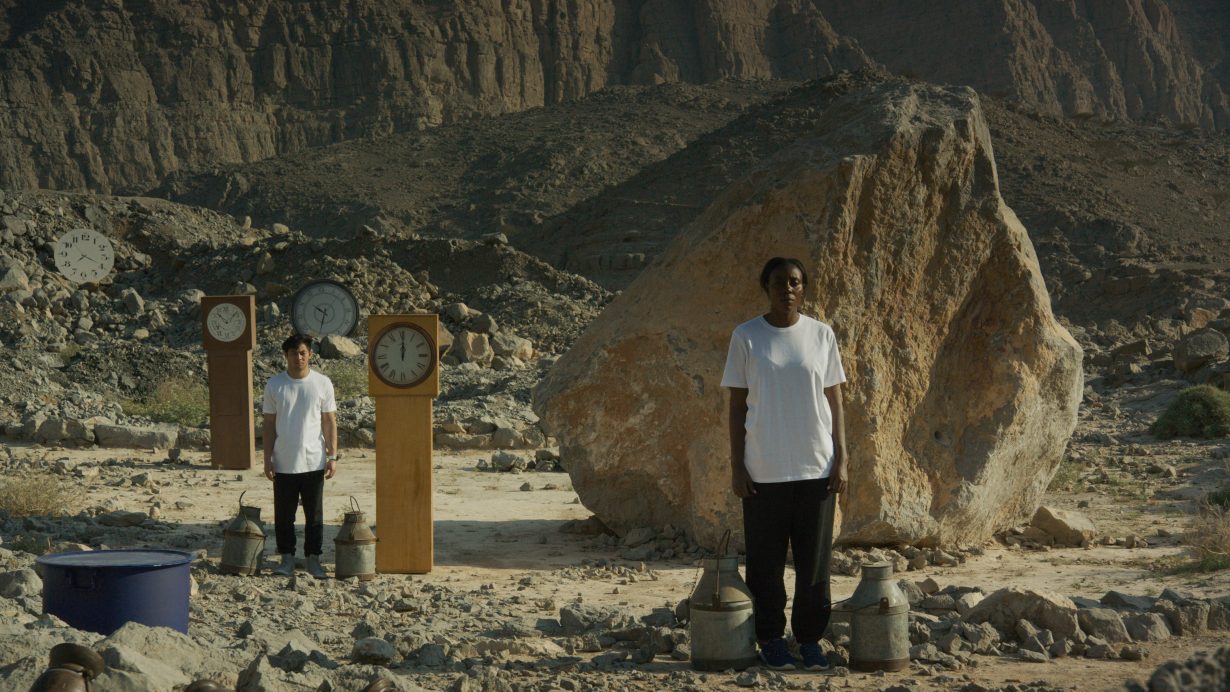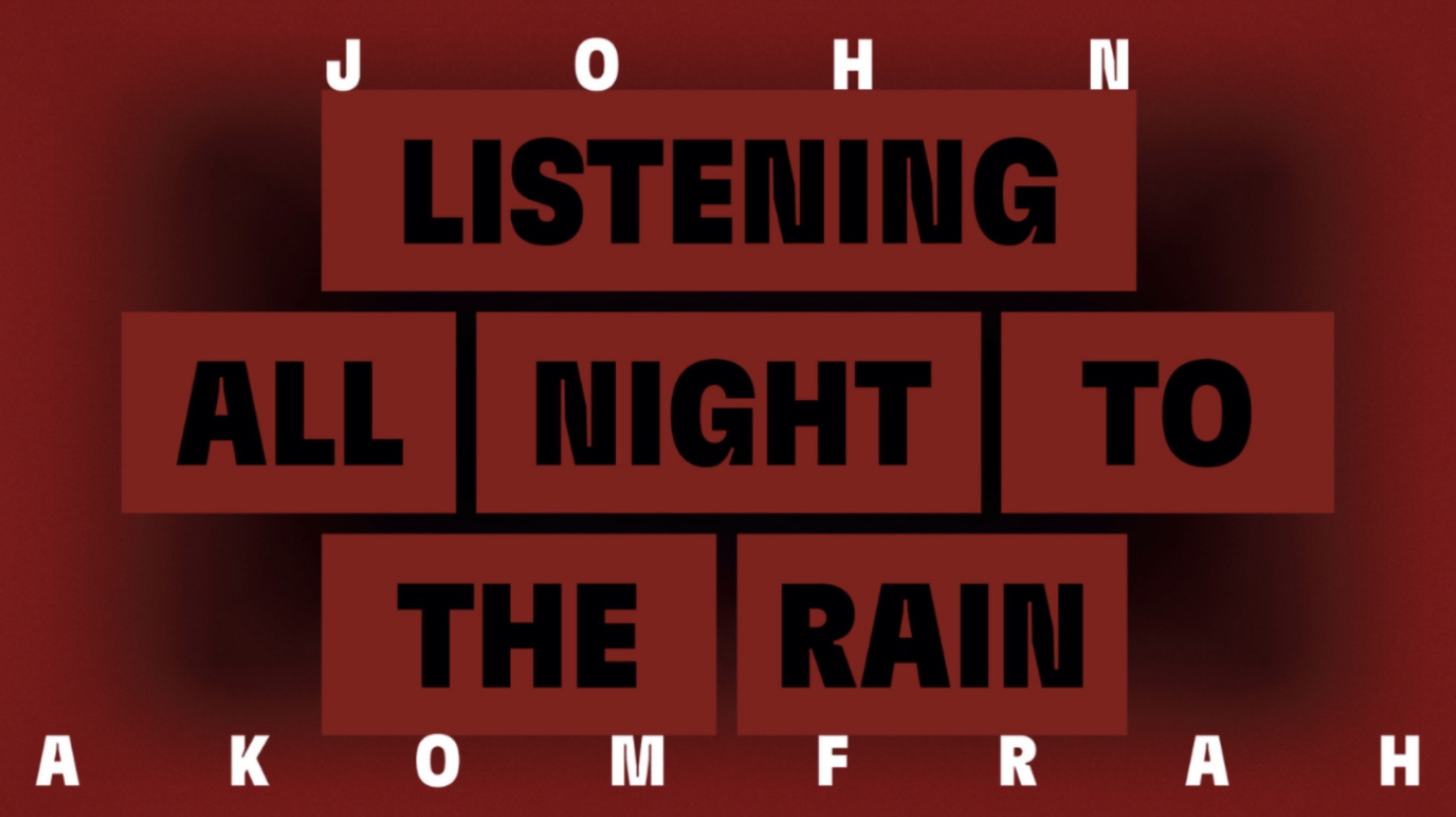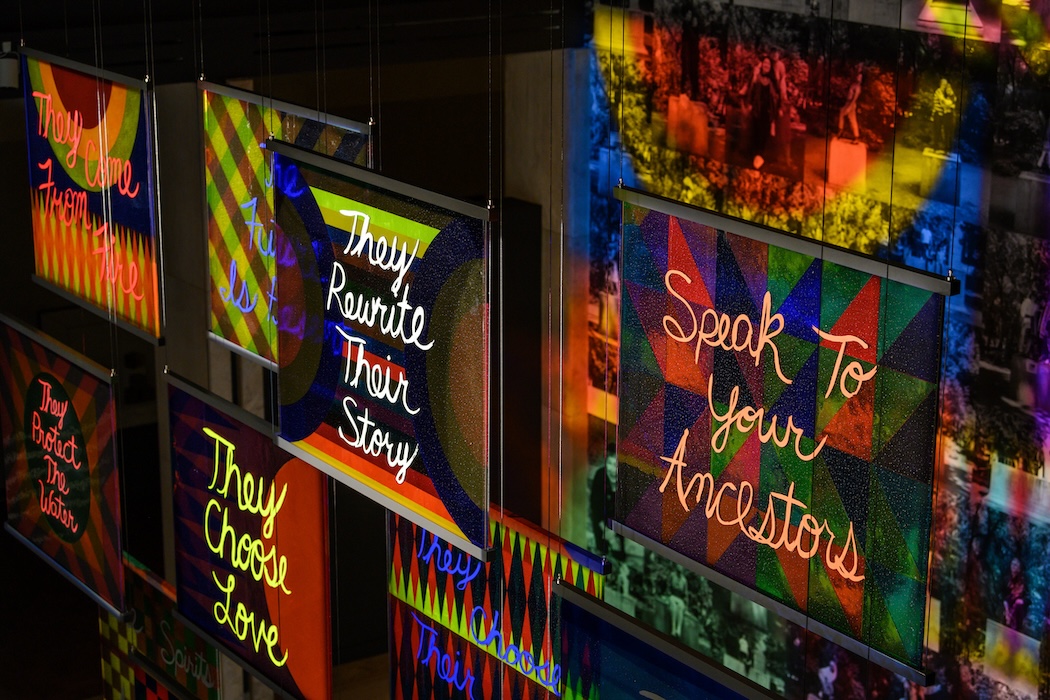John Akomfrah’s immersive exhibition “Listening All Night To The Rain” delves into themes that have resonated throughout his four-decade career, ranging from memory and migration to racial injustice and climate change.
This exhibition transcends conventional visual representation; in fact, it’s a call to action, encouraging audiences to listen attentively to the voices often marginalised or ignored. Akomfrah’s multi-layered installation invites viewers on a journey through the pavilion, where various media intertwine to create a dynamic exploration of contemporary issues. As visitors explore the space, they’ll encounter a rich array of sights and sounds, immersing them in the artist’s thought-provoking vision. Akomfrah’s exhibition commissioned by the British Council for the British Pavilion is scheduled to be open to the public from April 20th to November 24th, 2024.

Photo by Christian Cassiel. © John Akomfrah © Lisson Gallery.
Based in London, the artist first gained recognition in the early 1980s as a member of the Black Audio Film Collective (BAFC), a collective of seven artists established in 1982. The BAFC’s inaugural production, Handsworth Songs (1986), a gripping portrayal of the 1985 riots in Birmingham and London, garnered international acclaim and established a multi-layered visual style synonymous with Akomfrah’s practice. Nowadays, John Akomfrah stands as a towering figure in the realm of art and filmmaking, renowned for his profound explorations into memory, post-colonialism, temporality and aesthetics. His body of work often delves into the experiences of migrant diasporas on a global scale, offering poignant reflections on the human condition.

BAFC & John Akomfrah, “Handsworth Songs” (still), 1986. © Smoking Dogs Films and Lisson Gallery.
Throughout his career, Akomfrah has continued to push boundaries and challenge conventions. From the moving portrait of cultural theorist Stuart Hall in “The Unfinished Conversation” (2012) to the imagined drama of individuals depicted in two 16th-century portraits by Albrecht Dürer in “Peripeteia” (2012), his works offer profound insights into the complexities of human existence. Subsequent installations, such as “Purple” (2017), addresses climate change and human communities, and “Precarity” (2017), is a poignant exploration of forgotten jazz trumpeter Charles ‘Buddy’ Bolden’s life. The artist is also committed to shedding light on overlooked histories. This is evident in his installations like “Mimesis: African Soldier” (2018) that commemorate African and colonial participants of World War One.
Akomrah’s presence in Venice at the Biennale is not for the first time. In 2019, the artist unveiled “Four Nocturnes”, a reflective piece at the 58th Venice Biennale, exploring humanity’s destructive relationship with the natural world. Furthermore, in 2023, Akomfrah unveiled two major five-channel pieces at the 15th Sharjah Biennial: “Thinking Historically in the Present”: “Arcadia”, which reflects on “The Columbian Exchange” from the 1400s onwards, and “Becoming Wind”, an allegorical representation of the Garden of Eden and its disappearance. These installations showcase Akomfrah’s enduring ability to provoke thought and inspire contemplation, solidifying his position as a leading voice in contemporary art.

John Akomfrah, “Arcadia” (still), 2023. © Smoking Dogs Films © Lisson Gallery.
John Akomfrah’s artistic vision has been informed by his own experiences as a migrant in England. Originally from Ghana, Accra Akomfrah’s family was forced to leave the country as a result of the coup. Drawing this background, the themes of uprootedness and displacement, both on a personal and political level, pervade his work.
In his 2010 cinematic masterpiece “The Nine Muses”, which serves as a profound contemplation on the theme of migration, the filmmaker draws upon excerpts from John Milton’s immortal work, “Paradise Lost”, echoing a practice recurrent in his oeuvre. Akomfrah’s familial background emerges as a crucial backdrop of the film: his parents held prominent roles in Ghana’s struggle for independence, a movement culminating in the ascension of Kwame Nkrumah and his ambitious vision of pan-African socialism. However, the history took a tragic turn in 1966 when a CIA-backed coup toppled Nkrumah’s regime, leading to the death of Akomfrah’s father. Upon the demise of his father at the tender age of nine, Akomfrah experienced a profound feeling, as he conveyed to The Guardian, “There was that sense that everything good had turned bad. We were in danger. You knew as a kid there were people outside the house saying, we’re coming to get you. I couldn’t wait to be elsewhere.”
Prior to the departure from Accra to the US and later to London, the family bid farewell to his grandfather, the revered head of the Akomfrah lineage and the High Priest. The elderly gentleman was wearing a ring that was passed through generations and was steeped in familial history. This ring, represented the power to impose order upon life’s chaos and seemed like an ideal gift for the eldest grandson. Contrary to conventional expectations of inheritance, Akomfrah’s grandfather chose to swallow the ring instead of passing it on. This gesture led Akomfrah to interpret his grandfather’s action as a declaration of that ring’s power will end with Akhomrah’s grandfather. One might perceive Akomfrah’s artistic journey as an assertion against such convictions. John’s work continually brings order and justice to the chaos; in a way Akomfrah is the High Priest of the contemporary cinema.
Throughout his lifetime, John Akomfrah dedicated considerable effort to exploring notions of escape and refuge, with the latter holding a particularly poignant significance for him. When Akomfrah first moved to London from Ghana as a little boy, he initially felt a sense of fresh beginnings and happiness, as if he had discovered paradise in England. However, Akomfrah’s perception evolved over time. At school, he gradually discerned the disparity in treatment he received as an immigrant, leading to a sense of disenchantment as he realised his affection for Britain was not reciprocated. Consequently, John resolved to expressing his unrequited love in art.
In 1983, Akomfrah co-created his first film with the BAFC, delving into the intricate experiences of second-generation immigrants from the Commonwealth. This cinematic endeavour, entitled “Signs of Empire”, served as a poignant rebuttal to prevailing misconceptions surrounding the identity and place of these individuals within society. Akomfrah’s work aimed not only to challenge stereotypes but also to offer a nuanced perspective, one that reflected the complexity and diversity of immigrant narratives. Reflecting on his creative process, John emphasised the significance of representation in art. He recounted his own experiences of wandering through the halls of institutions like the Tate Gallery, only to realise the stark absence of narratives that resonated with his own. Through his films, Akomfrah sought to rectify this absence, to amplify voices that had long been overlooked or marginalised. His artistic journey became a testament to resilience, a continual defiance against narratives that sought to confine or erase the rich tapestry of immigrant experiences.
Since the 1980s, thanks to the tireless work by artists like John Akomfrah, the situation has changed, and art institutions have come to recognise their colonial past and involvement in the slave trade, with the need to represent neglected histories. Most recently, Akomfrah made work for the Royal Academy’s exhibition “Entangled Pasts, 1768–now”. This show is the most radical at the RA to date in terms of confronting Britain’s colonial history and that of its institutions, like the Royal Academy itself.
Artworks by prominent contemporary British artists of African, Caribbean and South Asian descent are showcased alongside pieces spanning the past two hundred and fifty years, creating a dynamic narrative that delves into themes of power, representation and history. Among these notable exhibits stands a cinematic masterpiece by John Akomfrah, “Vertigo Sea” (2015). Drawing inspiration from Ralph Waldo Emerson’s concept of “the sublime seas”, Akomfrah’s installation intricately weaves together archival materials, excerpts from classical texts and newly captured footage. His work illuminates the harsh realities of the whaling industry, juxtaposed with poignant scenes of African migrants navigating the treacherous ocean in search of hope, only to face brutality and death at the hands of oppressive forces. This discourse, rooted in historical context, mirrors the challenges faced by migrants in our contemporary era as they confront hostile anti-immigration policies.
John Akomfrah’s latest work, “Listening All Night To The Rain”, showcased at the 60th Venice Biennale, promises a captivating fusion of media that aims to provoke profound contemplation and stir vivid emotions. By placing the sonic realm at the forefront of the narrative, Akomfrah invites viewers to delve into the pressing issues of our time with heightened sensitivity and insight. With its innovative approach and thought-provoking themes, “Listening All Night To The Rain” pledges to etch a lasting impression, beckoning audiences to navigate and confront the intricate nuances of our contemporary world with newfound empathy and understanding.

John Akomfrah, “Listening All Night to the Rain” (2024). © John Akomfrah © British Pavilion 2024.








